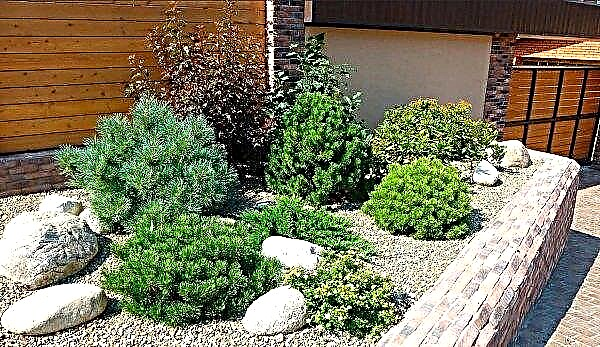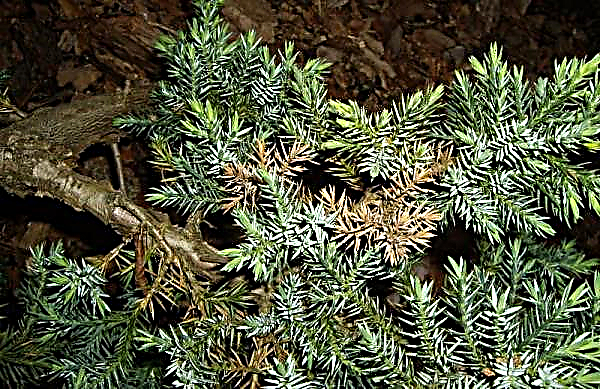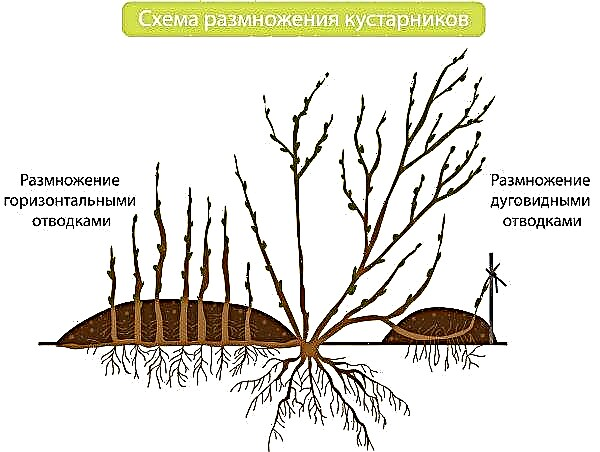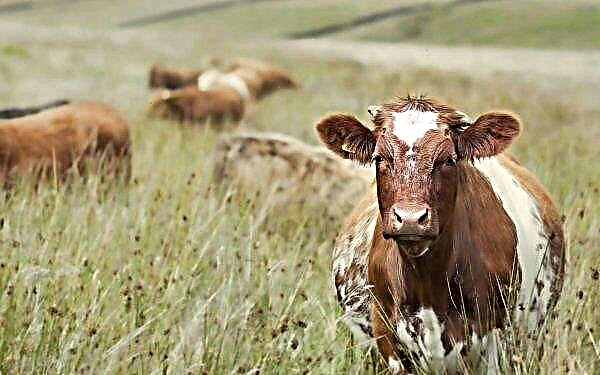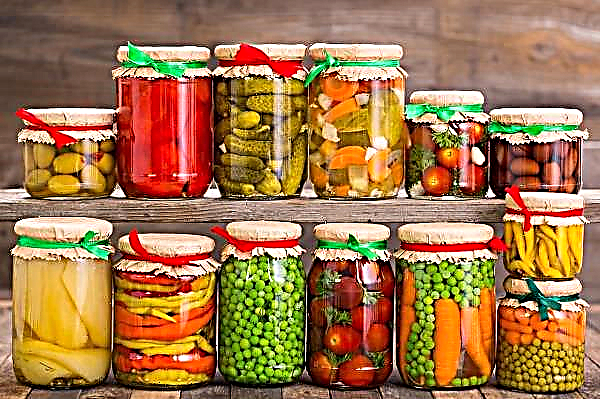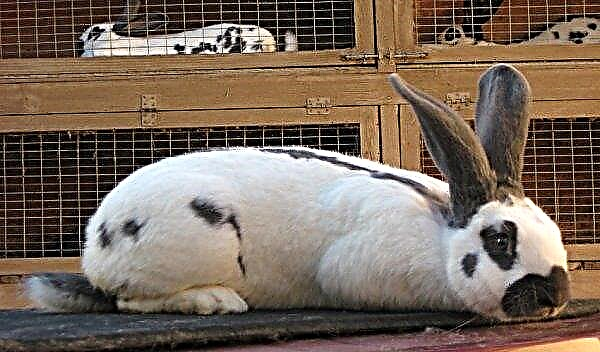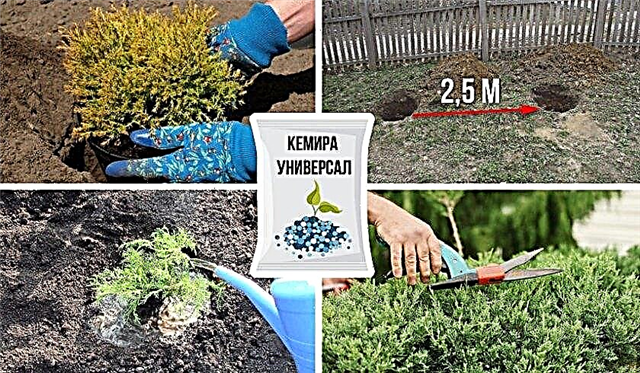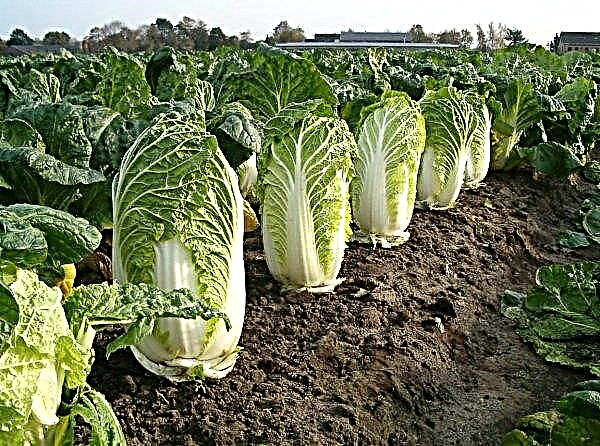Among the variety of conifers, there are not only the usual ordinary and cedar pine trees, but also a number of dwarf forms that are still little known in our region, which they managed to fall in love with in Europe. One of the brightest representatives is Sherwood Compact - a long-term unpretentious bush.
Tree description
Mountain pine Sherwood Compact (Pinus Mugo Sherwood Compact) - an evergreen dwarf shrub with a round, resembling pillow shape, dense crown. This variety was bred by Andy Sherwood, a breeder from Canada, in the 50s of the last century, and due to its properties, it does not lose its relevance today.

Appearance
By ten years, the plant reaches a height of 0.5 m in height, and up to 0.6 m in diameter. The needles are needle and short, bright green in color, which does not change even in the cold season. At a young age, it is characterized by a slow annual growth - only 5-6 cm, and in an adult shrub, from 2 to 5 cm per year is added. The cones are small in shape resembling an egg, light brown in color.
Where is growing
The habitat is Central and Southern Europe, especially the highlands. You can also meet pine in the alpine or subalpine mountain-forest belt at an altitude of up to 2500 m above sea level - it is considered a tree-forming species. It grows in the foothills, is protected in nature reserves.
Landing
Before you start planting, it is important to clean the selected place from weeds, especially perennial. It is recommended to buy planting material in a special plastic container with long-playing fertilizers, since in this case it is not subjected to damage to the root system and is guaranteed to survive. The optimal seedling age is 3-5 years
The optimal seedling age is 3-5 years
Detailed landing instructions:
- Having decided on the place (well-lit and warmed by the sun), prepare there a landing hole, which should be 2 times the seedling, as well as the soil mixture.
- Make a drainage system, and top it up with finished soil.
- Carefully pull the seedling out of the container with an earthen lump, place it in the pit so that the “neck” is necessarily above ground level.
- To fill up with fertile soil and carefully compact so that there are no voids in the soil.
- Form a near-stem soil and fill it with water to get on a seedling - for this, under the stream from a watering can, you need to put your hand.
- Mulch with peat 5-10 cm in order to retain moisture longer.

As for suitable soil - it should be sandy or sandy loam, preferably slightly acidic (pH 6–7). On heavy clay soils, planting is possible if a thick layer of drainage, about 10–20 cm, of expanded clay or broken brick fragments is poured onto the bottom of the dug hole.
The soil mixture is done independently. It includes:
- turf land - 3 parts;
- peat - 1 part;
- clean river sand - 1 part;
- complex fertilizer - 20-30 g (optional).
 All components are thoroughly mixed until smooth.
All components are thoroughly mixed until smooth.
Care Rules
If all the needs were taken into account when choosing a site for planting, then leaving will not cause much trouble. However, a standard list of procedures should be carried out regularly.
Did you know? Wood is characterized by an abundance of resin, elasticity and strength, which is why it is often used for the manufacture of turning and joinery.
Watering
Young pine of this variety needs abundant watering at least 2 times a week for the diameter of the planting recess. If the landing was made in the spring, and the summer turned out to be hot, then periodically it should be abundantly watered with light sprinkling. In late autumn, young pine seedlings require abundant watering, since moist soil does not freeze so much, which means that the likelihood of spring burning of needles is significantly reduced.
An adult tree does not need regular watering (except during periods of special drought and hot summer days) - it tolerates drought pretty well, and falling needles help retain moisture. As soon as the snow has completely melted, the pine is freed from the "shelter" and watered with warm water - this helps to wake up after hibernation.
Top dressing
During the first 2-3 years after planting a seedling, it is recommended that once a year during the early spring or late autumn dressing with a complex of mineral fertilizers or a mixture for conifers based on the consumption per 1 plant 30–40 g. After this time, the mountain pine no longer needs top dressing, since all useful substances will be delivered directly from the coniferous litter, which it itself will provide. When planting in a desert area, experienced gardeners recommend pouring seedlings with “Kornevin”, and after a month, feed them with fertilizer for conifers.
Mulching and loosening the soil
Almost all varieties of mountain pine take root extremely hard, so it is important to monitor them vigilantly. The first 1-2 years after planting, especially in the first months, care consists of careful cultivation and mulching with peat. This helps the roots get essential nutrients, moisture and oxygen. Adult mulching is enough - the procedure will help to maintain moisture and prevent the growth of weeds.
Haircut and trim
Shrubs do not need special pruning, however, if you want to slow down the growth of shoots in order to make the crown thicker, then in spring you need to cut no more than a third of the young shoots.
It is not necessary to use scissors - they can easily be broken off with your hands. In addition, you can resort to shaping haircuts, so that the pine tree retains its decorative shape. Do not forget about sanitary pruning, which is carried out annually in the spring.
Important! In order for the shoots to grow evenly, and also have protection against fungal diseases, the tree is fed and treated with a fungicide after the procedure.
Winter preparations
It is recommended to shelter young seedlings for the winter with spruce branches to protect them from severe frosts and sunburns in early spring. In addition, you can create a shadow using burlap or special covers. The only condition is not to use polyethylene or thick material, otherwise the seedlings may stagnate. In adulthood, such shelter is not required, it is enough only on days when the temperature is above 0 ° C to produce abundant watering.
Breeding
Sherwood Compact can be propagated by seed or vaccination. Cuttings practically do not take root, so the method is impractical. The plant begins to bear fruit from about 6 years: small cones (up to 4 cm) appear every two years near the end of autumn.
Reproduction by seeds is carried out in the spring, however, it is important to consider that varietal characters may not be preserved. The bush ripens only a couple of years after pollination, therefore this method is used for species developing in natural conditions. Seeds are collected and sent to ripen, only then applied for planting.Did you know? Young shoots and cones are used in cosmetology and medicine — when they are distilled with water, the so-called "Hungarian balm" is obtained.

Vaccination is the best option for breeding even the rarest varieties. It consists in building a young branch on an adult pine. The procedure is time-consuming and requires a certain base of knowledge and skills, so not every beginner gardener can do it.
Diseases and Pests
The plant is not prone to disease, but if not all the subtleties of agricultural technology have been taken into account, it can pick up something. Today, gardeners using the Internet can independently determine the ailment of mountain pine, as well as find drugs against this. Unprocessed shrubs before planting become the target of spider mites, scutes, red pine sawflies, as well as leaf-eating topworms. These insects often attack young shrubs, causing serious damage.
For the purpose of prevention, twice a year (in spring and autumn) is sprayed with insecticides.To protect Sherwood Compact from fungal infections and diseases, it is necessary to treat the bushes with fungicides, following the instructions.
Landscape design application
The plant is perfect for both single planting and group. In order to balance the composition, it is permissible to emphasize a mountain pine with two thin or, conversely, rough coniferous trees or shrubs. In addition, it is used in the creation of rockeries, heather, alpine or stone (Japanese) gardens, on the mountains and slopes, as well as for landscaping. You can resort to growing in containers.
Unpretentious decorative pine - a magnificent coniferous plant for any garden and site. Given all the above requirements and observing them, you can grow a bush that over the years will adorn any place where it is not planted.

